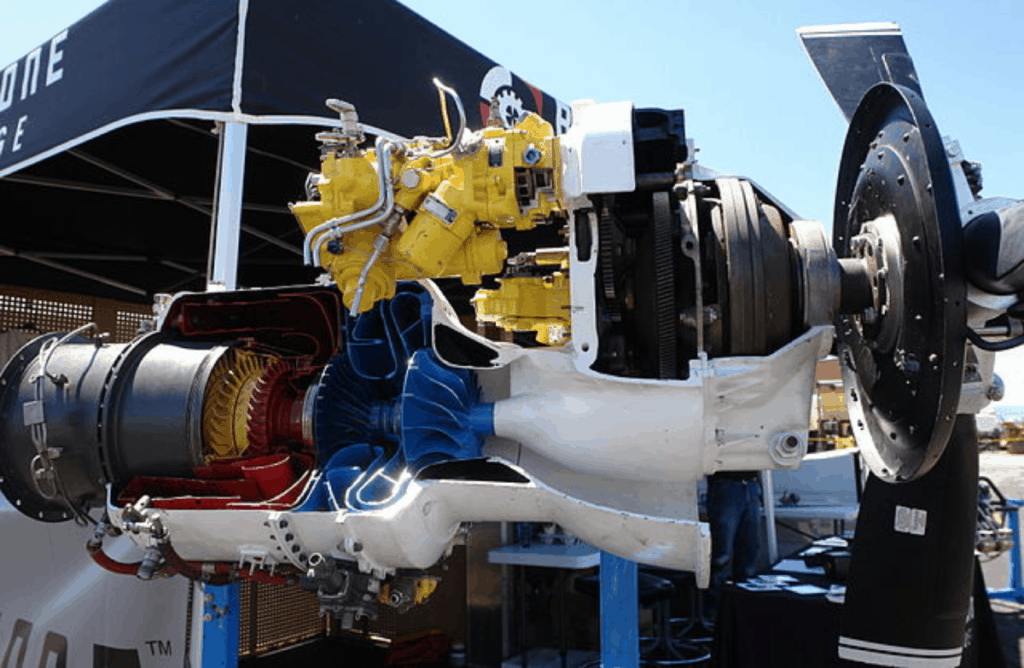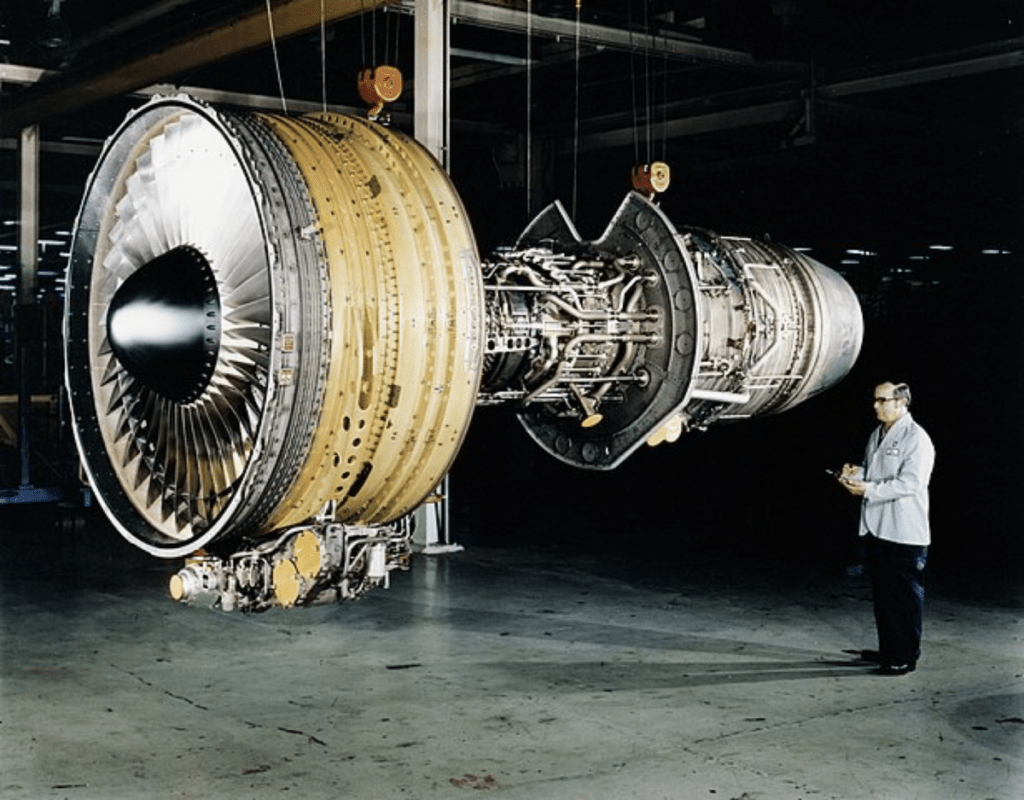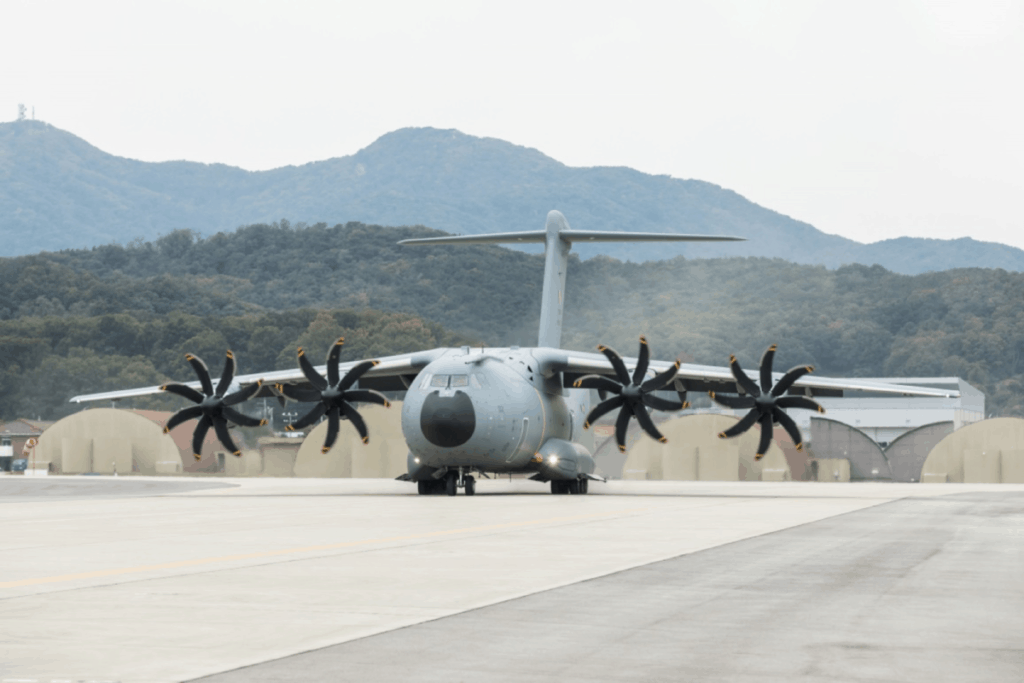
Turboprop and turbofan engines appear to be radically different machines. How do the fundamental differences in each engine type affect the safety, efficiency and performance of these engines? The underlying fundamental differences lay not the mechanical or thermodynamic processes, but rather in how the energy of the burned fuel is used. These differences in safety, efficiency, and performance all impact the application of these engines in aviation.
So, what is the fundamental difference between turboprops and turbofans?
Both turboprop and turbofan engines are gas turbine engines, meaning that thermodynamically they function identically. The differentiation is in how exhaust energy is used; turboprops use the exhaust drive a propeller, and turbofans accelerate the exhaust to produce thrust.
This post is part of a three-part series comparing piston, turboprop, turbofan, and turbojet engines. You can see the other two posts here:
- Turbojet vs. Turbofan: Safety, Efficiency, and Performance
- Piston vs. Turboprop: Safety. Efficiency, and Performance
Let’s go into more detail on the design differences between turboprops and turbofan engines and how that relates to safety, efficiency, and performance.
Turboprop vs. Turbofan: Design Differences
Thermodynamically, both engine types are similar and use the same thermodynamic cycle to create power and thrust. Fuel is burned to power a turbine that is used to power a compressor and any accessories.
The fundamental difference lies in how the remaining exhaust energy is used.
Turboprops extract virtually all of the kinetic energy and a larger portion of the thermal energy via expansion turbines to drive the propeller, while turbofans utilize an expansion nozzle to create high speed exhaust (thrust).

Image Credit

Image Credit
For turboprops, very little thrust is produced by the exhaust directly (2%-3% of total thrust output), the propeller does the work of converting heat to thrust via a gearbox driven by the expansion turbine.
It can be useful to think of turboprops as unducted turbofans in some sense, where the propeller is the first fan in the compressor section, however it should be noted that there is no actual bypass air for a turboprop engine. This analogy breaks down in a mechanical sense but is useful aerodynamically and thermodynamically.
The ideal turboprop would convert all of the exhaust’s energy into mechanical work to drive the propeller.
In contrast, the nozzles at the rear of turbofans act to reduce the volume of air leaving the back of the engine, which increases its velocity. This increase in velocity is the source of thrust. A wide range of parameters determines the design parameter for the nozzle, but ultimately the goal is to turn relatively high pressure, low velocity exhaust into high velocity, low pressure exhaust.
An ideal turbofan converts as little exhaust energy into mechanical energy as possible to maximize the velocity of the exhaust.
Turboprop vs. Turbofan: Safety
Both turboprops and turbofans are extremely reliable and safe engines. The safety challenges associated with each result from their respective installation requirements.
Propellers need space from the ground and from the fuselage, presenting unique aerodynamic challenges in the event of an engine failure. Additionally turboprops face higher vibration loads and mechanical complexity due to the need for a gearbox to reduce the turbine shaft speed to appropriate speeds for a propeller.
It is useful to review the aerodynamic and inertial properties of a propeller, namely Torque, P-Factor, and gyroscopic precession.
Torque is the opposing force generated by accelerating or decelerating a rotating mass (a propeller), P-Factor is the asymmetric thrust produced by a propeller when pitched away from level flight, and gyroscopic precession occurs when a rotating disk is acted upon outside of its plane of rotation.
These effects are commonly referred to as “left turning tendencies.” Student pilots are familiar with these effects in piston aircraft, both by experience and flight instructors dutifully preaching to use more right rudder.
These forces are most challenging for multiengine turboprops such as the King Air family of aircraft.
Consider a multi-engine propeller driven aircraft (turbine or piston powered is irrelevant to the example) experiencing a failure of the left hand engine during takeoff or go around. Torque on the remaining right engine will induce a roll to the right, gyroscopic effects from the nose up pitch induces a left hand turn, and most critically the thrust vector is offset outboard to the right due to P-factor.
The large size of turboprop propellers increases the magnitude and strength of these forces, particularly P-factor and the resultant offset thrust line relative the aircraft’s center of gravity.
Setting aside mechanical complexity, turboprop engines themselves are not less safe, but rather the resulting installation effects add a layer of risk that is less prominent in multi-engine turbofan aircraft.

Image Credit: FAA Airplane Flying Handbook
Turbofan engines are able to be mounted much more closely to the aircraft fuselage and thus benefit from dramatically reduced asymmetric thrust effects in the event of an engine failure.
This is not to say that torque and gyroscopic precession do not occur in these engines, but the effects are substantially reduced. Turbofan installations also benefit from reduced mechanical complexity as they do not require the large reduction gearboxes needed to slow turboprop propellers to appropriate speeds.
Additionally, because turbofans supply substantial amounts of thrust using bypass air, the engine may provide bleed air for anti-icing, pressurization and other systems. Turboprops in contrast do not have any bypass air, making the use of bleed air a substantial impact to overall engine performance.
As a result, turbofan aircraft tend to have more robust pneumatic systems relative to their turboprop cousins.
Turboprop vs. Turbofan: Efficiency
The primary differentiation between turboprops and turbofans with regard to efficiency is operating speed range; this is primarily the result of aerodynamic properties of propellers and turbofan engines.
Ultimately efficiency and performance are related, but it is useful to understand that both engines are only capable of producing thrust so long as they are able to accelerate air to a speed higher than the surrounding airspeed. Thrust output tapers as the engine’s ability to accelerate the incoming air tapers.
The question then arises what: aerodynamic properties govern this process?
For turboprop engines, it is propeller speed.
As the power output of the engine increases, the prop diameter must also increase to “absorb,” that is, transfer, the power output to useable thrust. That’s because in order to control the engine’s RPM to the appropriate speed (at a given power setting), there needs to be sufficient load on the engine to control speed, which is fundamentally a function of propeller blade area. There a few ways to do that (assuming fixed pitch): add blade length, add blades, and/or chord to each blade.
A good example of this is the Airbus A400M which has eight large diameter long chord blades.

Image Credit: Airbus
If for a second we limit the increased blade area to diameter only using two or three blades, the A400 would have enormously huge props. As a result much of the blade would operate in the sonic to supersonic range because as propeller diameter increases, propeller tip speed increases, meaning that sufficiently large propellers approach or break the speed of sound at the tip of the propeller.
Once propellers enter the trans-sonic to sonic speed range, efficiency and thrust output drops dramatically as shockwaves destroy the lift that results in thrust.
Diameter is the most efficient method of loading the engine, but because the rotational velocity increases as a square of the radius, eventually it’s simply moving too fast to stay sub-sonic, which is when designers begin adding blades, chord, etc.
Functionally most turboprops are limited to 1700 or 1800 RPM as a result of the large diameter props.
For example, the Cessna Denali has a 5 blade 105 inch prop that will operate between 1700 and 1800 RPM depending on phase of flight. Any faster rotational speeds would start to structurally overload the blades and mostly turn fuel into noise instead of thrust.
As turboprops climb to higher altitudes, shock formation begins to occur sooner due to higher true airspeeds, which effectively limits propeller performance.
As a result, most turboprops are limited to Mach 0.5 to 0.6, and altitudes in the 35,000 foot range, with a handful of turboprops reaching the Mach 0.7 and 40,000 feet.
These aircraft use complex propeller designs and massive engines; but still operated well below the Mach 0.9+ and 50,000 foot altitudes turbofans are capable of achieving.
A range of propeller design techniques are available to achieve high cruise speeds, from increasing the number of blades, to the use of finely tuned swept blade tip designs to improve high speed efficiency.
By contrast, speed has very little impact on turbofan thrust output.
Compressor sections require intake air to remain within a specific velocity range, notably sub-sonic. Intakes are designed to manage intake air and slow it to the appropriate speed. Turbofan thrust at a given altitude is fairly constant across the operating speed range, allowing the aircraft to continue accelerating at higher altitudes. Altitude effects on turbofan engines are driven primarily by the availability of air to be burned, meaning total available thrust decreases with altitude.
Because turbofans continue to produce thrust at high speeds, the aircraft is able to balance reduced thrust output at altitude against lower atmospheric density.
As a result of these factors, turbofan engines are most efficient relative to operating speeds at higher altitudes.
Functionally, engine efficiency becomes a function of internal operating temperatures, compression ratio and nozzle design.
It is worth noting that for roughly equivalent turboprop and turbofan engines (in terms of power output), turboprop engines tend to have lower fuel burns at a given set of atmospheric conditions. The efficiency of a turbofan is thus a function of the speed it is able to produce.
The benefit of speed for turbofans results in shorter flights being more efficient in turboprops and longer flights more efficient in turbofans. Once again engine choice for maximum efficiency is related to the design goals for the aircraft.
Turboprop vs. Turbofan: Performance
Because performance and efficiency are inextricably linked, each metric is relative to the design goal for the aircraft. In comparing turboprops and turbofans, two performance envelopes emerge as a result of the aerodynamic limits of the two engines.
At high altitudes propellers begin to suffer reduced performance from shock formation and reduced air density (remember that propellers are rotating wings).
While the turbofan engine is susceptible to reduced thrust output with altitude, it maintains the thrust across the operating speed range, meaning aircraft performance is primarily limited by drag.
To the extent that designers are able to increase combustion, exhaust and nozzle temperatures, turbofan engines can continue to produce thrust so long as sufficient air is ingested. The memorable example of this being the SR-71 Blackbird, its ability to cruise at altitudes above 70,000 feet and at speeds around Mach 3 is a testament to going higher and faster if sufficient air and fuel is available.

In contrast, turbofans suffer performance degradation at low altitudes as a result of airframe drag penalties. The full thrust capability of the engine is not available because of airframe speed limits.
As a result, turboprop aircraft can often meet or exceed the performance of a turbofan aircraft at low altitudes.
An example of this is the TBM 930 and the Cirrus Vision Jet. Ultimately these two aircraft accomplish the same basic mission but the TBM can do so with slight speed and efficiency advantages. The denser air at lower altitudes allows the turboprop’s propeller to operate at peak efficiency, thus maximizing aircraft performance.
The performance limits of turboprop engines are thus a function of propeller diameter and propeller drag. In contrast, turbofan engines are limited by the mechanical rotational and thermal limits of the engine.
As a result, each engine allows for maximized performance in particular operating environments; turboprops at lower altitudes and speeds, turbofans at higher altitudes and speeds.
Turboprop vs. Turbofan: Conclusion
Both engine technologies are safe and reliable, with installation effects of turboprops driving increased safety considerations. Turboprops are most efficient and perform best at low altitude and airspeeds up to Mach 0.6 in most cases whereas turbofans are most efficient at high altitudes and are speed limited by their intake design.
Turboprops and turbofans are independent solutions for independent design goals and problems.
Additional reading related to this topic:



